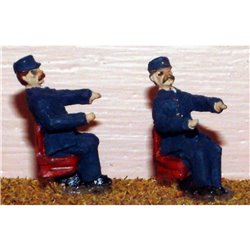Static grass puffer bottles work by manually charging model grass fibres with static electricity. When the charged...
No products
Product successfully added to your shopping cart
There are 0 items in your cart. There is 1 item in your cart.
Search Tips
How to fit drivers in locomotives
Installing a driver or fireman into your locomotive can really bring it to life and add realism. After all, in real life, if you saw a steam locomotive hurtling down the tracks without a crew on board, then something has gone very wrong!
Fitting them is easy too, and involves nothing more than glueing them to the footplate of a steam locomotive or removing the bodyshell and planting one in the driver's seat if using a diesel. The glue you use is up to you, typically, model drivers are available in plastic or white metal (the latter requiring a stronger glue) but if you are intending to remove the crew at some point, then you might want to consider using a product such as Tacky Wax that will hold the figure in place temporarily but allow you to easily remove it at a later date should you wish.
You can get driver and fireman figures painted or unpainted and in several styles depicting different eras, so have a good rummage at your local model shop to find one that is right for your loco.
Click here to receive the tips weekly in your mailbox. You can unsubscribe at any time.










